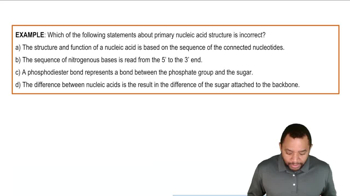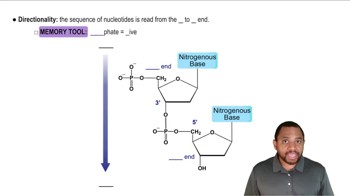Here are the essential concepts you must grasp in order to answer the question correctly.
Nucleic Acid Structure
Nucleic acids, such as DNA and RNA, are polymers made up of nucleotide monomers. Each nucleotide consists of a sugar, a phosphate group, and a nitrogenous base. The structure of nucleic acids is directional, with a 5' end (phosphate group) and a 3' end (hydroxyl group), which is crucial for understanding their function in biological processes.
Recommended video:
Primary Structure of Nucleic Acids Example 2
5' and 3' Ends
The 5' end of a nucleic acid strand has a free phosphate group attached to the fifth carbon of the sugar, while the 3' end has a free hydroxyl group on the third carbon. This polarity is essential for DNA and RNA synthesis, as nucleotides are added to the 3' end during replication and transcription, determining the directionality of the strand.
Recommended video:
Primary Structure of Nucleic Acids Concept 2
Functionality in Biological Processes
The differences between the 5' and 3' ends of nucleic acids are critical for their roles in cellular processes. For instance, during DNA replication, enzymes like DNA polymerase add nucleotides to the 3' end, ensuring that the new strand is synthesized in a 5' to 3' direction. This directional synthesis is vital for accurate genetic information transfer and expression.
Recommended video:
Processing of Pre-mRNA Concept 1
 Verified step by step guidance
Verified step by step guidance


